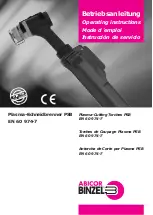
— 11 —
List of supported engine and transmission warnings is available in Appendix D. One Device can handle
events from all engines, or you can link it to a particular engine by NMEA 2000 engine instance. For
example, you can use two separate Devices (each one with its own dedicated speaker), one for port
(instance 0) and another for starboard (instance 1) engine.
4. Events, channels, sounds, flash sequences and links between them
You can configure sound alarms and external LED signals linked to different events. In MOB mode, only the
event with number 1 is used. In other modes, all 28 events (with numbers from 1 to 28) are associated with
28 digital switching channels or 28 supported engine and transmission warnings.
The Device memory contains 28 pre-recorded sound signals (see the Appendix B) and 28 LED flashing
sequences (see the Appendix C). In factory default settings, the sound signal number 1 and flashing
sequence number 1 are linked to event 1 and so on.
You can listen to pre-recorded sounds and look at LED flashing sequences using YD:PLAY and YD:LED
commands and set desired sound and flashing sequence for each event using YD:LINK command
(see the Section V). To disable or enable the event use YD:EVENT command.
If different events occur at the same time, event with lowest number will have highest priority,
Device will play sound and show LED flashing sequence linked with this event.
In engine alarm mode, pressing the button will suppress the current event for 30 seconds (time can be
changed in settings) for all engines. If multiple engine warnings occurs at the same time, the next event
will be activated.
In digital switching mode, connected button either turns channel/event 1 ON/OFF (channel/event number
can be changed in settings) or if multiple channels/events were already turned ON, each button press will
turn OFF an active channel/event, in order from lowest to highest priority.
For example, if you turn ON channels 1, 2 and 4 from external digital switching control equipment, Device
will play the sound and show LED sequence corresponding to the event 1. When you press the button,
channel 1 will be turned OFF and the Device will play the sound and show LED sequence corresponding
to the event 2. Next button press will turn OFF channel 2 and Device will play the sound and show LED
sequence corresponding to the event 4. Next button presses will turn OFF channel 4.












































